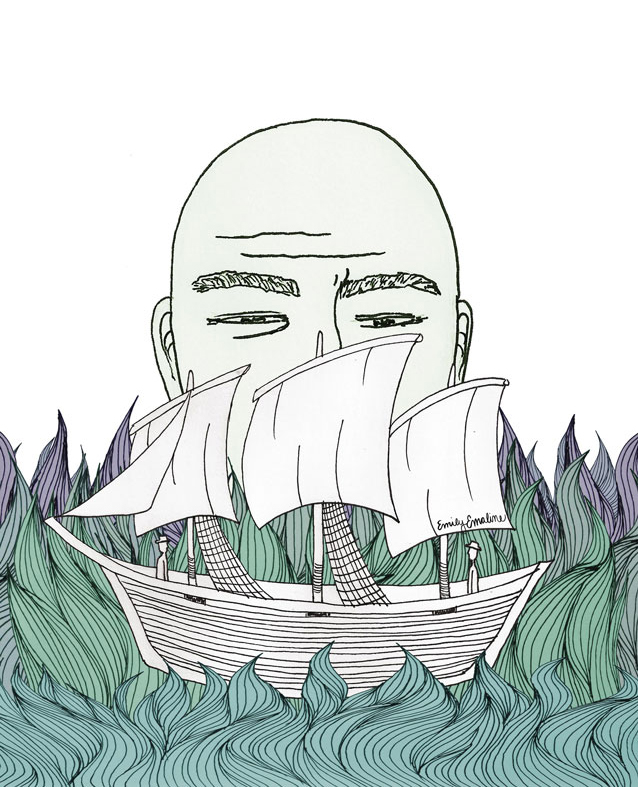A Friend for Frankenstein Caitlin Crawford
Every summer for the last three years, I’ve read Mary Wollstonecraft Shelley’s Frankenstein: or The Modern Prometheus. It has by far been my favorite book since I first encountered it, like most, as a summer reading assignment in high school. The legend goes that Shelley composed the storyline out of a dream during a rainy Geneva summer in the early 19th century. She, her husband Percy Bysshe Shelley, and Lord Byron among others were to all write a ghost story, but only she completed the task. Frankenstein’s themes have never felt like a summer to me, and this year, I waited for a riper time to give it a read. Every repetition of a familiar thing can bring some new detail to light, but this time the story evoked brand new feelings when in a menage a trois with traveling and autumn.

Many
conversations tell this story: between one maritime adventurer and his sister,
between Frankenstein and his companions, and between the creature and the
world. They are interweaving webs with many differences but three quests in
common: for purpose, for knowledge, and for companionship. The framing of the
story maintains a freshness. The majority of the narration comes from records,
retellings and letters. The anxiousness of the characters waiting for
correspondence from one another comes from the desire that we all feel to
connect. The dates of the letters have always struck me. Sometimes Frankenstein
will go months without responding to his friends or family, as his obsessions
take him all over Europe. Imagine having to wait that long, and what that
feeling must to do to the person carrying it. We feel this same emotion now,
but often only for days, minutes or just seconds. But this distance, whether
only proverbial or true can be the definition of agony.
The
narrator, Walton, a man of simple upbringing and self education, has a thirst
for knowledge and adventure. He commissions a crew and ship, which ultimately
bumps into Frankenstein floating with what’s left of his sled and dog team on a
piece of ice. Walton narrates through letters with his sister and recording
Frankenstein’s tale. He hopes his voyage “. . .may regulate a thousand
celestial observations, that require only this voyage to render their seeming
eccentricities consistent forever. I shall satiate my ardent curiosity with a
sight of a part of the world never before imprinted by the foot of man,” but
has trepidations, “I greatly need a friend who would have sense enough not to
despise me as romantic and affection enough for me to endeavour to regulate my mind. . . .I shall certainly find no friend here in the wide
ocean.” But the chance finding of Dr. Frankenstein and his undying quest for
the same ends satiates all of Walton’s needs.
In
exchange for the ship to carry him in pursuit of his daemon, the
creature to which he gave life, Frankenstein will tell the tale of that very
creation. He too sought to tread on unbreached ground, that which Shelley states in the preface, “. . .has been supposed by
Dr. Darwin, and some of the physiological writers of Germany, as not of
impossible occurrence.” He labors for months, forsaking his true
companions--his father, his best friend Clerval and
his dear Elizabeth--at the hubris of trying to invent a creature that could
match his self-perception of an ultimate man, a perfect companion. But on
bringing that creature to life, Frankenstein abhors himself and his newly
animated being.
The
creature stows away on a farm and learns all of his language, knowledge and
skills from watching the family that lives there. He observes their daily tasks
with curiosity and their interactions with tenderness. He wants desperately to
be a part of their home. But when he reveals himself, the people that he has
come to love from a distance revile him as much as his creator. This leads him
on a quest to find Frankenstein and have him create a counterpart. When the
good doctor refuses, the creature exacts his revenge by taking the very thing
away from Frankenstein that he denies his daemon, his companions. When Walton,
Frankenstein and his creature all come together, they finally forge a
connection between the desires and understandings of all three. “You, who call
Frankenstein your friend, seem to have a knowledge of my crimes and misfortunes.
But in the detail which he gave you of them he could not sum up the hours and
months of misery which I endured, wasting in impotent passions.”
Frankenstein taps into a longing that every man and creature
feels--a longing for companionship, understanding and acceptance. Shelley takes
us on a lonely journey full of desperate pursuit of that which we lack. A sense
of travel, a sense of purpose, and a sense of belonging. The former two often
encumbering the latter. Shelley touches a nerve that we all have, the one that
starts at the back of the neck and goes straight to loins. The same nerve that
tells our whole bodies that they’re excited, they’re afraid, or that they’ve
made a grave mistake. Sometimes it’s our lot in life to be alone, but more
often, it’s our choices and actions that leave us in despair.
Caitlin Crawford sleeps late when she needs to, takes a daily walk in the park
and gets to play with dogs for a living. Life has never been better.
Illustration by Emily Emaline emilyemaline.com
